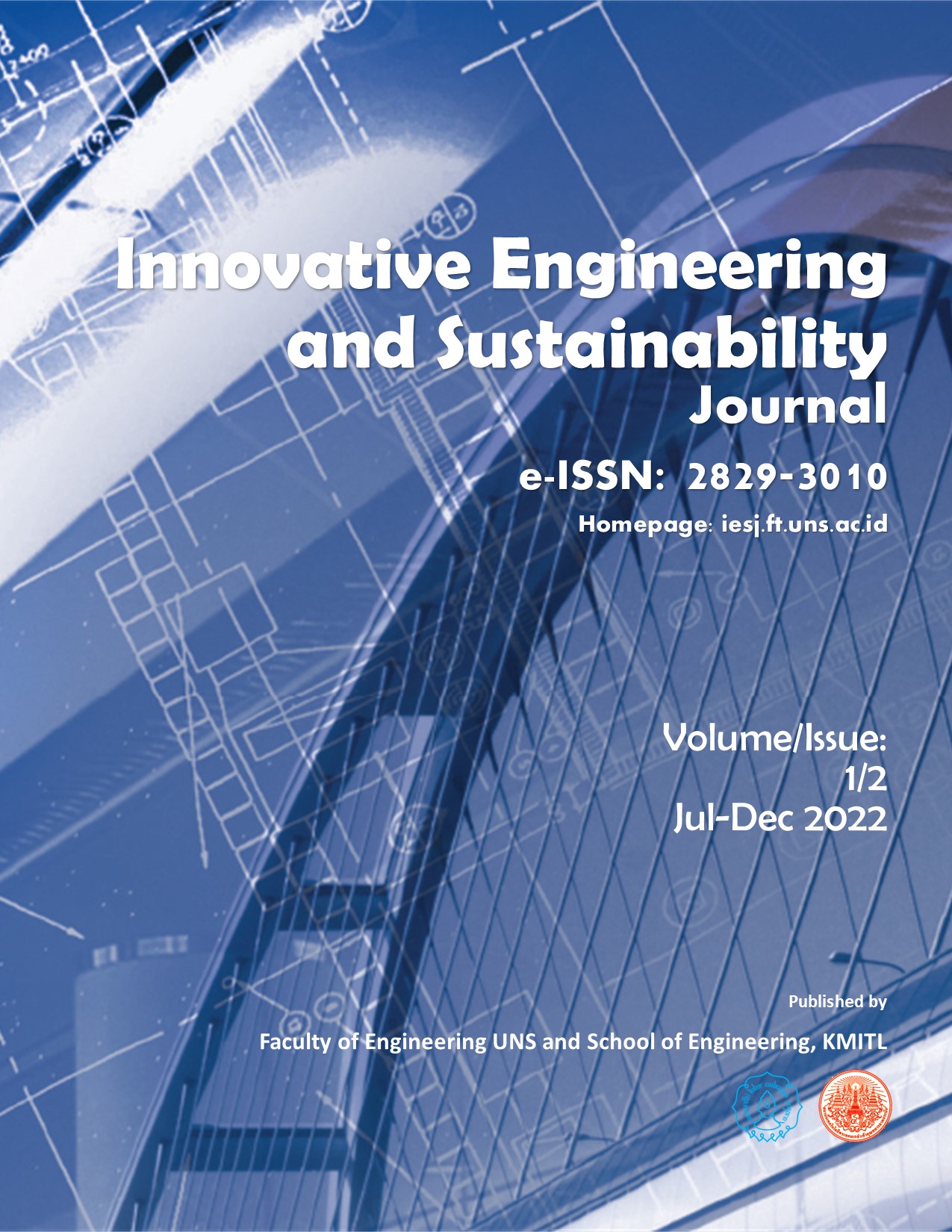Main Article Content
Abstract
There are many parameters of the watershed that govern the hydrologic responses in the process of rainfall-runoff process. One of the parameters is geomorphological parameters. Some parameters have been well known for their contribution to streamflow discharge, the other parameters do not. We explore some geomorphological parameters that strongly influence the hydrologic response of a watershed but received inadequate attention to be investigated and discussed. We refer to a rainfall-runoff model in which rainfall is the primary input parameter and runoff in the stream is the output. By identifying a number of rainfall-runoff and other hydrologic models, the data parameters required to run the mode and obtain the output i.e. flood could be identified. We concluded that the watershed parameters of the hypsometric curve, watershed shape, drainage density, channel length, channel slope, channel cross-section, Horton’s stream, and degree of meandering, are important watershed parameters but lack attention from scholars.
Keywords
Article Details

This work is licensed under a Creative Commons Attribution-NonCommercial-NoDerivatives 4.0 International License.
References
- Bedan, E S; Clausen, J C;. (2009). Stormwater runoff quality and quantity from traditional and low impact development watersheds 1. Jawra journal of the american water resources association, 45(4), 998-1008.
- Beven, K. (2004). Robert E. Horton's perceptual model of infiltration processes. Hydrological processes, 18(17), 3447-3460.
- Chen, Z. Q., Kavvas, M. L., Yoon, J. Y., Dogrul, E. C., Fukami, K., Yoshitani, J., & Matsuura, T. (2004). Geomorphologic and soil hydraulic parameters for Watershed Environmental Hydrology (WEHY) model. Journal of Hydrologic Engineering, 9(6), 465-479.
- Chow, V. T. (1962). Hydrologic design of culverts. Journal of the Hydraulics Division, 88(2), 39-55.
- Daniel, E. B., Camp, J. V., LeBoeuf, E. J., Penrod, J. R., Dobbins, J. P., & Abkowitz, M. D. (2011). Watershed modeling and its applications: A state-of-the-art review. The Open Hydrology Journal, 5(1).
- Duan, Q., Gupta, H. V., Sorooshian, S., Rosseau, A. N., & Turcotte, R. (2003). Calibration of watershed models (Vol. 6). John Wiley & Sons.
- Jena, S K; Tiwari, K N;. (2006). Modeling synthetic unit hydrograph parameters with geomorphologic parameters of watersheds. Journal of hydrology, 319(1-4), 1-14.
- Haktanir, T., & Sezen, N. (1990). Suitability of two-parameter gamma and three-parameter beta distributions as synthetic unit hydrographs in Anatolia. Hydrological sciences journal, 35(2), 167-184.
- Hingray, B., C. Picouet, & A. Mussy (2015). Hydrology: A Science for Engineers. CRC Press.
- Kirpich, Z. P. (1940). Time of concentration of small agricultural watersheds. Civil engineering, 10(6), 362.
- Koutsoyiannis, D. (2006). Nonstationarity versus scaling in hydrology. Journal of Hydrology, 324(1-4), 239-254.
- Koutsoyiannis, D. (2013). Hydrology and change. Hydrological Sciences Journal , 58(6), 1177-1197.
- Lacey, G. (1958). FLOW IN ALLUVIAL CHANNELS WITH SANDY MOBILE BEDS. Proceedings of the Institution of Civil Engineers, 9(2), 145-164.
- McCuen, R. H. (1998). Hydrologic Analysis and Design. New Jersey 07458: Prentice Hall Inc.
- Prepas, E E; Burke, J M; Whitson, I R; Putz, G; Smith, D W. (2006). Associations between watershed characteristics, runoff, and stream water quality: hypothesis development for watershed disturbance experiments and modelling in the Forest Watershed and Riparian Disturbance (FORWARD) Project. 5(S1), S27-S37.
- Singh, V. P., & Frevert, D. K. (2010). Watershed Models. CRC.
- Yang, M., Zhang, Y., & Pan, X. (2020). Improving the Horton infiltration equation by considering soil moisture variation. Journal of Hydrology, 586.
- Watt, W. E., & Chow, K. A. (1985). A general expression for basin lag time. Canadian Journal of Civil Engineering, 12(2), 294-300.
References
Bedan, E S; Clausen, J C;. (2009). Stormwater runoff quality and quantity from traditional and low impact development watersheds 1. Jawra journal of the american water resources association, 45(4), 998-1008.
Beven, K. (2004). Robert E. Horton's perceptual model of infiltration processes. Hydrological processes, 18(17), 3447-3460.
Chen, Z. Q., Kavvas, M. L., Yoon, J. Y., Dogrul, E. C., Fukami, K., Yoshitani, J., & Matsuura, T. (2004). Geomorphologic and soil hydraulic parameters for Watershed Environmental Hydrology (WEHY) model. Journal of Hydrologic Engineering, 9(6), 465-479.
Chow, V. T. (1962). Hydrologic design of culverts. Journal of the Hydraulics Division, 88(2), 39-55.
Daniel, E. B., Camp, J. V., LeBoeuf, E. J., Penrod, J. R., Dobbins, J. P., & Abkowitz, M. D. (2011). Watershed modeling and its applications: A state-of-the-art review. The Open Hydrology Journal, 5(1).
Duan, Q., Gupta, H. V., Sorooshian, S., Rosseau, A. N., & Turcotte, R. (2003). Calibration of watershed models (Vol. 6). John Wiley & Sons.
Jena, S K; Tiwari, K N;. (2006). Modeling synthetic unit hydrograph parameters with geomorphologic parameters of watersheds. Journal of hydrology, 319(1-4), 1-14.
Haktanir, T., & Sezen, N. (1990). Suitability of two-parameter gamma and three-parameter beta distributions as synthetic unit hydrographs in Anatolia. Hydrological sciences journal, 35(2), 167-184.
Hingray, B., C. Picouet, & A. Mussy (2015). Hydrology: A Science for Engineers. CRC Press.
Kirpich, Z. P. (1940). Time of concentration of small agricultural watersheds. Civil engineering, 10(6), 362.
Koutsoyiannis, D. (2006). Nonstationarity versus scaling in hydrology. Journal of Hydrology, 324(1-4), 239-254.
Koutsoyiannis, D. (2013). Hydrology and change. Hydrological Sciences Journal , 58(6), 1177-1197.
Lacey, G. (1958). FLOW IN ALLUVIAL CHANNELS WITH SANDY MOBILE BEDS. Proceedings of the Institution of Civil Engineers, 9(2), 145-164.
McCuen, R. H. (1998). Hydrologic Analysis and Design. New Jersey 07458: Prentice Hall Inc.
Prepas, E E; Burke, J M; Whitson, I R; Putz, G; Smith, D W. (2006). Associations between watershed characteristics, runoff, and stream water quality: hypothesis development for watershed disturbance experiments and modelling in the Forest Watershed and Riparian Disturbance (FORWARD) Project. 5(S1), S27-S37.
Singh, V. P., & Frevert, D. K. (2010). Watershed Models. CRC.
Yang, M., Zhang, Y., & Pan, X. (2020). Improving the Horton infiltration equation by considering soil moisture variation. Journal of Hydrology, 586.
Watt, W. E., & Chow, K. A. (1985). A general expression for basin lag time. Canadian Journal of Civil Engineering, 12(2), 294-300.
